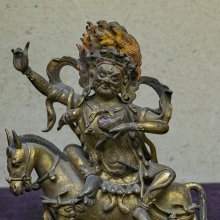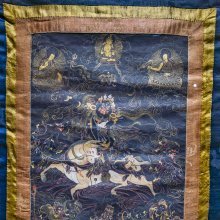Chvaskamini, Chhwaskamini, Chvasakamini, Chvaskāminī, Chvāsakāminī, Chvāskāminī: 2 definitions
Introduction:
Chvaskamini means something in the history of ancient India. If you want to know the exact meaning, history, etymology or English translation of this term then check out the descriptions on this page. Add your comment or reference to a book if you want to contribute to this summary article.
Alternative spellings of this word include .
Images (photo gallery)
India history and geography
Source: academia.edu: KirtimukhaChvaskamini refers to the mother goddess who resides in the place where household debris is discarded and eventually turns into manure.—The Buddhist Newars of the Kathmandu Valley believe that Sri Devi is the same as Chvaskamini.
Source: Asian art: Elements of Newar Buddhist ArtChvāsakāminī (छ्वासकामिनी) (or Ugracandī) according to Buddhist Newars represents the dreadful goddess who resides at chvāsa and is identified with Palden Lhamo. Chvāsa is a place originally distant from the Newar residential area where trash and debris are deposited and where are ritually thrown the clothes and other belonging of a dead person, as well as newly born children’s umbilical cords. Chvāsakāminī causes and cures pediatric diseases. An examination of Newari paintings reveals that she is popular in them as well as in Tibetan paintings.

The history of India traces the identification of countries, villages, towns and other regions of India, as well as mythology, zoology, royal dynasties, rulers, tribes, local festivities and traditions and regional languages. Ancient India enjoyed religious freedom and encourages the path of Dharma, a concept common to Buddhism, Hinduism, and Jainism.
See also (Relevant definitions)
Partial matches: Chvasa, Kamini.
Full-text: Palden lhamo.
Relevant text
No search results for Chvaskamini, Chhwaskamini, Chvasakamini, Chvaskāminī, Chvāsakāminī, Chvāskāminī, Chhvasa-kamini, Chhvasa-kamini, Chhvaskāminī, Chhvāsa-kāminī, Chhvasa-kāminī, Chvāsa-kāminī, Chvasa-kamini, Chvasakāminī, Chvasa-kāminī, Chhvasa-kāminī, Chhvāskāminī, Chhvāsa-kāminī, Chhvasakāminī, Chhvaskamini, Chhvasakamini, Chhvāsakāminī, Chwaskamini, Chhwasakamini; (plurals include: Chvaskaminis, Chhwaskaminis, Chvasakaminis, Chvaskāminīs, Chvāsakāminīs, Chvāskāminīs, kaminis, Chhvaskāminīs, kāminīs, Chvasakāminīs, Chhvāskāminīs, Chhvasakāminīs, Chhvaskaminis, Chhvasakaminis, Chhvāsakāminīs, Chwaskaminis, Chhwasakaminis) in any book or story.

